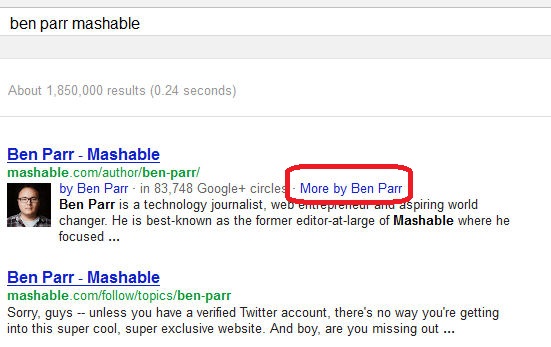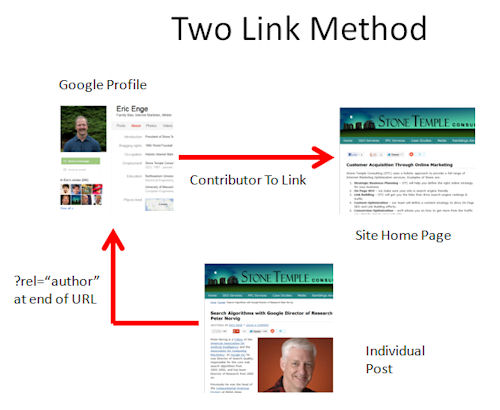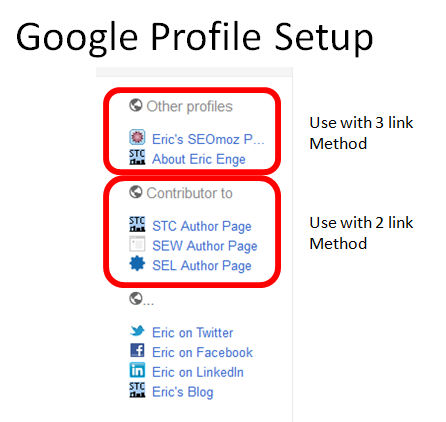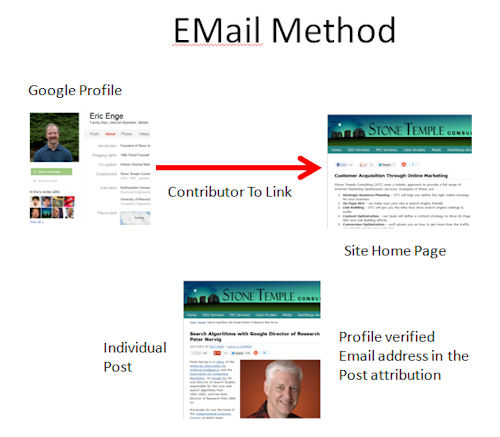
Key Points from Interview with Sagar Kamdar
This interview transcript is from the March 13th, 2012 conversation I had with Sagar Kamdar, who heads up the authorship program at Google. This provided some simple, straightforward clarity on how it works, and some of the various scenarios for implementation. Here are some of the key points from the interview:
- Google sees the authorship program as a way to connect authors and readers who are a fan of their work.
- The original 3 link method is still supported. This is documented in detail in the main interview, along with a graphic image of how it works.
- They came up with the 2 newest methods because people were having trouble executing the 3 link method, in some cases because it was too confusing.
- The 2 link method only requires that the content on the site link to the author’s Google profile with a ?rel=author parameter, and the Google profile lists the site in the “Contributor To” section of the profile. This is documented in detail in the main interview, along with a graphic image of how it works.
- The email method only requires that your email address be verified and use the domain name of the site where the article is published, and that the email be included in the attribution for the article. This is documented in detail in the main interview, along with a graphic image of how it works.
- The email method was created because some authors do not have the ability to add a link as specified in the 2 link method.
- It is OK to put sites in the Contributor To section (provided you contribute to them) even if you don’t get rel=author links back.
- The Authorship Request functionality has been retired, though there is a simple form there now for verifying an email for the Email method.
- Anyone who properly implements rel=author is eligible for participation. It only requires that you have a high-quality photo in your Google profile.
- When you first show up depends primarily on crawling and indexing time. This may take days or weeks depending on your site.
Full Interview Transcript
Eric Enge: Can you provide us an overview of your background and your role at Google?
Sagar Kamdar: Sure, I am a product manager on the search team. I have been at Google for about four years, spent most of my time on search, spent my time on a variety of projects like real-time search, and webmaster tools. Actually, my first project was external evangelism with search engine specialists and most recently I have been focused on authorship and some of our social search efforts that you have seen out in the wild.
Eric Enge: There has been this longstanding problem of people who are the original author of content not necessarily being the first to show up for their content, and I think that it is really great that we are starting to have a method by which authors are identified. Can you provide some thoughts on what the authorship program is all about?
The main thing that we are trying to address is the faceless nature of the web.
Sagar Kamdar: The main thing that we are trying to address is the faceless nature of the web. For many years people have been clicking on content not knowing who created it, and not knowing who commented on it. What we are seeing is that users really want to know who created that bit of content. Users know who their favorite authors are, and we’re trying to make it easy for them to communicate with those author(s).
We want to make it easy for authors to get setup and then for searchers to be able to find the content they create. So if they search for “iPad” and they like David Pogue, they are more likely to see what David Pogue has written about the iPad. Authors benefit as well because they get attributed to their content and also they can engage with the users in a way they haven’t before.
Eric Enge: I think it is particularly interesting when you look at it because many well-known authors are published on many different sites.
Now we have this feature where users can say show me all content by Ben Parr, for example.
Sagar Kamdar: It is actually one of the coolest features we have for authors. We have all these people that are publishing on five or six different publications and their own blog and users can’t keep track of all that content. Now we have this feature where users can say show me all content by Ben Parr, for example.
Editor: This is how it looks in Google’s search results:
 |
Editor: Here is the Author Page for Ben Parr on Google:
 |
A user could actually type in a query and see all the content he has written about that subject matter if he has linked his content appropriately. It is a really cool way of aggregating content by an individual.
Eric Enge: Great, there are a few ways to set this up. Let’s talk a bit about those. There is the original method which was what people called the three-link method. This is where the Google profile, the author page, and the article page were interlinked with one another. Is that method still supported?
The reason we actually changed to our two most current methods is just because the original method was hard for many people.
Sagar Kamdar: Yes, we still support the original method that we had blogged about. The reason we actually changed to our two most current methods is just because the original method was hard for many people.
We have been in pilot mode for a while because this is something that is new to us and we wanted to make sure that we are doing this in a way that our authors can understand and users can understand, and it was just too hard for people to implement the approach that we had originally discussed.
Eric Enge: Let me outline briefly what the three-link method is and then we will do it for the other two methods. The three-link method was as follows:
- The author’s Google profile page would point to your Author page on the site with the content with a rel=”me” tag specified in the “Other Profiles” section.
- The author page on the site with the content points to your Google profile page with the rel=”me” tag also.
- Finally, each individual article page would need to point to your author page with a rel=”author” tag.
Is that correct?
Sagar Kamdar: Yes, that is correct.
 |
Eric Enge: Okay, so that was the 3 link method. Can you outline the details of the way the other two methods work then?
Sagar Kamdar: We have the 2 link method which works as follows:
- You link directly to your Google profile from the content you create and append the ? rel=”author” parameter at the end of the URL.
- In your Google profile, you just say you write content for this site. You do that by filling in the “Contributor To” section of your profile.
 |
Eric Enge: In the Contributor To box, does that point to the homepage of the site or the blog section of the site?
 |
Sagar Kamdar: To the homepage of the site.
Eric Enge: If it points to the blog section, is that bad or does that still work?
Sagar Kamdar: That still works.
Eric Enge: If you write for multiple sites, is it possible that you would get rel=author tagging from some sites, but not from others, even if everything is properly tagged?
Sagar Kamdar: I don’t think so. It is most probably a problem in the configuration and best thing to do is to go to the Rich Snippets testing tool, put in a sample URL from one of the articles and see where it may have identified an incorrect setup.
Eric Enge: Can you talk through how the email method works?
Note that we just launched a simple tool to verify your email address.
Sagar Kamdar: This method assumes you have an email address on the domain that you write for. So, if you are writing for CNET, it assumes you have an email address like yourname@cnet.com. If you do have such an email address, you can verify that email address on your profile and that gives us a signal that you may have some association with CNET, and then we try to figure out using heuristics whether the name on your profile or the name you claim to have actually matches up with articles that are written by that same individual. Note that we just launched and email address verification tool.
 |
Eric Enge: At this point, the 2 link method and the email methods are the ones that you recommend. What are the advantages and disadvantages of each?
Sagar Kamdar: Sometimes authors don’t have the ability to add additional links from the bio portion of their article or they need to request their webmaster to make some tweaks to enable that. The email method doesn’t require any modification to the website to get set up, so it is possible that you could get set up a little bit faster for that than the 2 link method. In addition, with email verification, it is far more dependent upon our heuristics and analysis to figure out if content is associated to your Google profile and that’s a science that we are constantly tuning.
Eric Enge: Right, presumably, you can look at signals such as whether or not a piece of content is something that a person would’ve written, is it in the right place on the CNET site where they typically write. Of course, if it is an article on CNET then CNET probably isn’t going to allow other people to use your email address on their article for example.
Sagar Kamdar: Correct. We do a bunch of things and we are still learning since we are in pilot mode. We launched email verification relatively recently, a couple of months ago, and as we get broader adoption we learn new things from our users of what they expect. Of course, you need to have an email address on the domain that you write for. It doesn’t really work for a contributing guest columnist that does not have email on that domain. In that case, the writer would have to use the 2 link method.
Eric Enge: If you are writing in multiple locations, you would have to have multiple email addresses, one associated with each domain.
Sagar Kamdar: Yes.
Eric Enge: Do either these have an advantage where you have multiple authors in the same site or they are both relatively equivalent for that?
Sagar Kamdar: That should not make much difference. It is more about what is easiest for you to implement.
Eric Enge: You already talked about “Contributor To” and how that works, is there any harm if you put things you are a contributor to when you yet don’t have links back from the articles on those sites?
Sagar Kamdar: No, that’s totally fine. I think people may visit your profile and want to see what other sites you write for, and it is a good way for you to fill out your profile and let people to see that. So, it may not impact authorship but just having a nice profile that has all the information about you that you feel is relevant to somebody that would visit you I think is totally cool.
Eric Enge: The Contributor To box is relatively new, right, when did that go up?
Sagar Kamdar: That went up four or five months ago, and we have already been through a learning process. Originally, you had to put in a link in the Other Profiles box and then click a checkbox to say, this is about me. If you clicked on
that checkbox, you would actually click the rel=”me” tag. People get confused by different options like this, and they would say everything on my profile is about me, why do I have to click on the checkbox? We decided to create three distinct sections on the profile page to make it easier for people visiting your profile to understand it, and also for authors to get setup.
Anything you add in other profile sections will be a rel=”me” link, anything you add in Contributor To will be a contributor link and then recommended links are links you think are cool that people should check out.
Eric Enge: If you originally filled in the rel=”me” links as part of Other Profiles, and then added them to “Contributor To”, but did not delete the original stuff from Other Profiles, is that a problem?
Sagar Kamdar: No problem at all.
Eric Enge: Can you talk a bit about the Rich Snippets testing tool?
Sagar Kamdar: The Rich Snippets testing tool can be used to tell you if you have implemented your rel=”author” markup correctly. For example, it will tell you if you have linked from your article to your Google profile but haven’t put a Contributor To link back to the site. This works well with the 2 link method, or the 3 link method, but it does not yet work for testing the email verification method. We are working on adding that.
Eric Enge: To test your markup, you should take an individual article URL and see how that does, correct?
Sagar Kamdar: Yes.
Eric Enge: Once things are properly implemented, what decides which authors will end up getting their properly tagged articles show the modified search results? And, how long does it generally take before the modified results show up?
Sagar Kamdar: The basic criteria is that you are set up correctly, you provide a high-quality photo of yourself, and then based on our algorithm when your content shows up, we just try to make sure the photo would be relevant to the user. In terms of timeline, it just depends on the frequency of how often we crawl and index your content which is variable, based on sites. We just follow the natural progression of our crawling and indexing technology and it could be set up in days or it could take weeks.
Eric Enge: In terms of the photo, you mean it needs to be something in your Google profile, right?
Sagar Kamdar: Yes, the photo you upload as part of your profile.
Eric Enge: You might have a different photo on each of the individual sites that you write in, those photos don’t need to be the same, you are mostly concerned about the one in the profile, correct?
Sagar Kamdar: Yes.
Eric Enge: Basically most people, as long as they do some reasonable amount of writing online, ought to be able to qualify for this, it is just a matter of crawling time and proper setup.
Sagar Kamdar: Yes.
Eric Enge: That’s excellent. What did I leave out?
Sagar Kamdar: We are really excited about this program as it provides authors and readers an opportunity to connect. It is also great for users to see the author’s picture associated with their content, and it provides a whole new way for authors to engage with their audience. We believe the authors are starting to see the benefit and so are the readers.
Eric Enge: I imagine that this will feed into social signals and author authority in the long term. Does that make sense?
Sagar Kamdar: Yes, you could eventually see that type of thing happening.
Eric Enge: Thanks Sagar!
Sagar Kamdar: Yes, thank you Eric!
About Sagar
Sagar Kamdar is a Group Product Manager for Google Search. Sagar is responsible for Google’s authorship and social initiatives in search. Prior to joining Google, Sagar was a Director responsible for Analytics products at Oracle. Sagar has a BS degree in EE from Cornell University.
